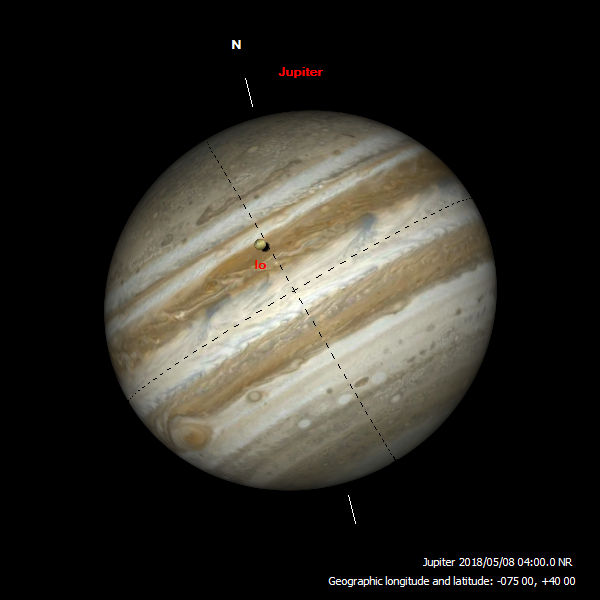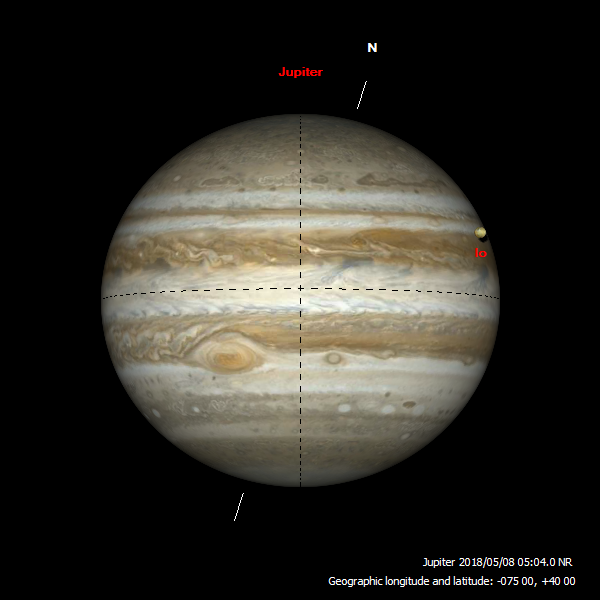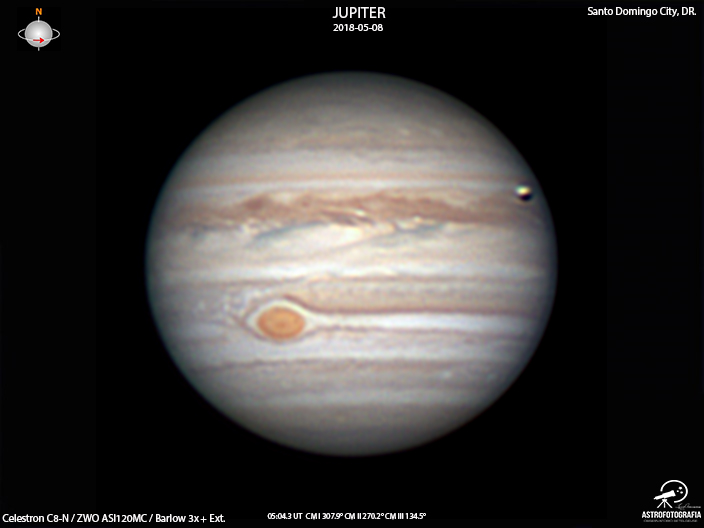
Jupiter Near Opposition
Great Red Spot and Io
Transits
Tuesday Morning, May 8, 2018

The planet Jupiter will reach opposition on May 8, 2018, at 8:39 pm EDT. Late on the evening of May 7 and extending into the early morning hours of May 8, there will be simultaneous transits of Jupiter's satellite Io, almost superimposed on its own shadow, and the Great Red Spot (GRS).
The image above was generated by WinJUPOS, showing Jupiter at 4:00 UT (0:00 EDT) on May 8. Celestial north is up (as indicated by the white bars) and east is to the left, so the rotation would be from left to right in this "correct," direct view. The dashed lines on the disc represent Jupiter's central meridian (CM) and equator.
In the image, Io is nearly at the CM, but Io and its shadow will begin ingress over the disc a couple of minutes before 11 pm EDT on May 7, then egress from the disc a couple of minutes after 1 am on May 8. Since Jupiter is less than a day before opposition, Io is almost directly over its shadow.
The GRS transits the CM at 1:42 am on May 8. It will emerge from the eastern limb shortly after 11 pm on May 7 and disappear behind the western limb shortly after 4 am on May 8. However, it is best placed for observation about +/– an hour from the CM transit. The GRS times used here were generated with WinJUPOS, and confirmed with SkyTools, using a GRS longitude of 293° (System II) in each case. Sky & Telescope's online GRS utility indicated transit at 1:43 am, but the GRS longitude wasn't clearly stated Incidentally, Sky & Telescope recently posted a nice online article by Bob King about observing Jupiter at this opposition.
SkySafari versions 5 & 6 have the GRS transit at 1:22 am using a GRS longitude of 281°, but this longitude appears to be out of date (valid for December 2017 per the JUPOS online table), and consequently, that transit time is probably inaccurate. My experience has shown that WinJUPOS provides accurate GRS transit times. For Io and its shadow, WinJUPOS, SkyTools, S&T and SkySafari all agree on the transit times.
Since Jupiter has a rotation period just under 10 hours, the second GRS CM transit after the one discussed above will occur at 9:33 pm on May 8, 1:42 after Jupiter rises at 7:51 pm (for 40°N-75°W) when it will be at 17° altitude.
Update: The weather cooperated and Jupiter was observed from 10:45 pm on May 7 until 2:15 am EDT on May 8 (02:45 until 06:15 UT on May 8) using a Stellarvue 130 mm f/7 apo refractor, mainly with 4.7 and 3.6 mm Stellarvue Optimus 110° eyepieces, which provided 194x and 253x with 34 and 26 arc minute true fields of view respectively. Io was observed creeping up to Jupiter's eastern limb, and once it was in front of the Jovian disc, it was quite obviously a disc when seen against limb darkening (1.14" diameter per WinJUPOS).
Observing with the 130 mm scope, all of the Galilean satellites looked like tiny discs in the open sky, but because of dazzle from their brightness against a dark sky, they were not as clearly discs as Io was when seen against the limb-darkened edge of Jupiter's disc. After moving farther into the disc, Io disappeared, but it's shadow became visible, like a black "bullet hole." The crescent shape of the partially-covered shadow was not evident. As Io approached the western limb, the distinct disc reappeared and the shadow disappeared. The WinJUPOS synthetic image below shows Jupiter at 1:04 am EDT (05:04 UT) on May 8, just as Io reached the western limb. Below that, I found an image at ALPO-Japan taken at the same time from roughly the same longitude (the Dominican Republic).

WinJUPOS Synthetic Image, North Up, East Left (direct view)

Image by Luis Amiana Gomez, Dominican Republic, via ALPO-Japan; North Up, East Left (direct view)
Observing with the 130 mm scope, the Great Red Spot was first detected about 11:35 pm EDT, but not well seen since it was still relatively close to the eastern limb, so visibility was limited by foreshortening (it was more-or-less on the side of a spheroid rathere than the side of a flat disc). After a break in observing, it was easily seen around 12:30 am. The color was distinctly a brick-reddish color, unlike the pale peach color it was a few years ago ("The Great Peach Spot"), but it was also a bit smaller and left a prominent gap between the GRS and the Southern Equatorial Belt. The WinJUPOS synthetic image shows an older version that fills the hollow (or eye socket as I call it) in the SEB.
I watched Jupiter on-and-off until about 2:15 am on May 8. Besides things described above, there was generally a lot of surface detail to be seen by the patient eye, including a couple of bluish festoons dangling from the Northern Equatorial Belt. Initially, around 11 pm, the seeing was fair at best, with the edges of Jupiter's disc being rather woozy. By 1 am, when Jupiter transited the celestial meridian, seeing was good (but not great).
The 130 mm apo refractor performed well. Besides the detail observed on Jupiter, a few double stars were observed and easily split, e.g., both pairs of the Double Double (Epsilon Lyrae), Rasalgethi (Alpha Herculis), Izar (or Pulcherrima, Epsilon Boötis). The dim secondary of bright Antares (Alpha Scorpii) still eludes me. I may have seen brief appearances of the secondary amidst the woozy rays beaming off the bright primary, but not conclusively enough to claim a sighting. I'll just have to wait for better seeing at its low altitude.
Last Update: Friday, May 18, 2018 at 02:25 PM Eastern Time